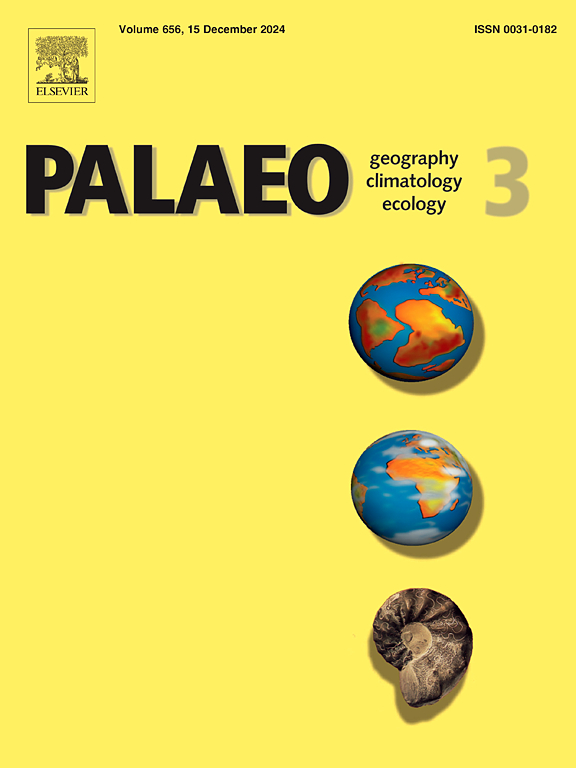近500 ka河套盆地与黄河古湖泊的共同演化
IF 2.7
2区 地球科学
Q2 GEOGRAPHY, PHYSICAL
Palaeogeography, Palaeoclimatology, Palaeoecology
Pub Date : 2025-05-17
DOI:10.1016/j.palaeo.2025.113038
引用次数: 0
摘要
河套盆地的河湖和风成沉积提供了区域古环境变化的记录,可用于约束古黄河的演化。本文为河套盆地中更新世至全新世沉积序列提供了新的年代学。结合新的微古生物学成果和已有的地球化学和生物资料,重建了河套盆地近500 ka的水文地质演化。根据现有的野外资料和水平衡模型,我们认为河套盆地的古湖泊至少在~ 450 ka以前发育,随后分别在间冰期和冰期扩张和收缩。古湖泊的峰值面积可能达到34000平方公里,覆盖了河套盆地的大部分地区,主要由黄河供水。然而,在约128 ka,由于明显的湿润和温暖的气候,湖泊溢出,随后黄河重新整合,可能沿着一条近现代的路径流出河套盆地。在此过程中,古湖泊面积缩减约85%,仅保留在河套盆地西部。这个较小的古湖泊直到大约5千年前仍由黄河的一条支流喂养。研究结果较好地将河套盆地晚第四纪古湖泊的水文地质历史限定在冰期-间冰期的时间尺度上。这些发现不仅对重建古黄河演化具有重要意义,而且对认识黄土高原区域风成动力学和水力侵蚀过程具有重要意义。本文章由计算机程序翻译,如有差异,请以英文原文为准。
Co-evolution of palaeolakes in the Hetao Basin and the Yellow River over the last 500 ka
The fluvial-lacustrine and aeolian deposits in the Hetao Basin provide a record of regional palaeo-environment changes that can be useful for constraining the evolution of the palaeo-Yellow River. Here, we provide a new chronology for middle Pleistocene through Holocene sedimentary sequences in the Hetao Basin. Combined with new micropaleontological results and previous geochemical and biological data, this framework reconstructs the hydro-geological evolution of the Hetao Basin over the last 500 ka. Based on the available field data and water balance modeling, we suggest that the palaeolakes in the Hetao Basin developed at least ∼450 ka ago, and subsequently expanded and contracted during interglacial and glacial intervals, respectively. The peak palaeolake area may have reached 34,000 km2, covering most of the Hetao Basin, and would have been predominantly fed by the Yellow River. However, at ∼128 ka, the lake overflowed due to a significant wetter and warmer climate, and afterwards the Yellow River became reintegrated, flowing out of the Hetao Basin, likely along a near-modern pathway. During this process, the palaeolake area shrunk by about 85 % and only remained in the western part of the Hetao Basin. This smaller palaeolake was still fed by a branch of the Yellow River until about 5 ka. Our results better constrain the late Quaternary hydro-geological history of palaeolakes in the Hetao Basin on glacial-interglacial timescales. These findings are not only important for reconstructing the evolution of the palaeo-Yellow River, but also for understanding regional aeolian dynamics and hydraulic erosion processes in the Chinese Loess Plateau.
求助全文
通过发布文献求助,成功后即可免费获取论文全文。
去求助
来源期刊
CiteScore
5.90
自引率
10.00%
发文量
398
审稿时长
3.8 months
期刊介绍:
Palaeogeography, Palaeoclimatology, Palaeoecology is an international medium for the publication of high quality and multidisciplinary, original studies and comprehensive reviews in the field of palaeo-environmental geology. The journal aims at bringing together data with global implications from research in the many different disciplines involved in palaeo-environmental investigations.
By cutting across the boundaries of established sciences, it provides an interdisciplinary forum where issues of general interest can be discussed.

 求助内容:
求助内容: 应助结果提醒方式:
应助结果提醒方式:


